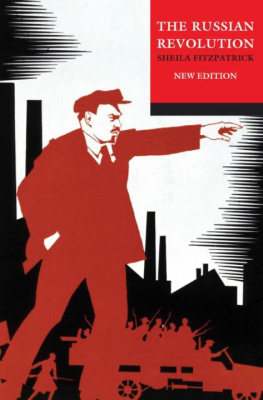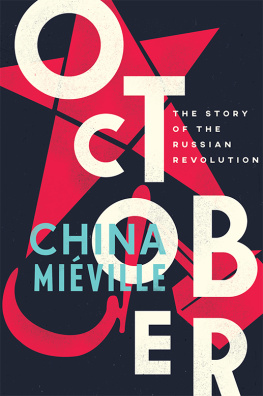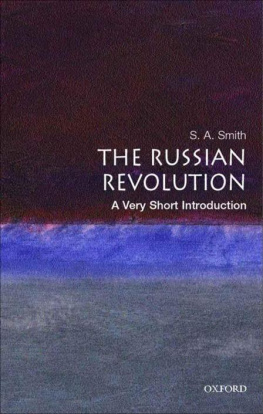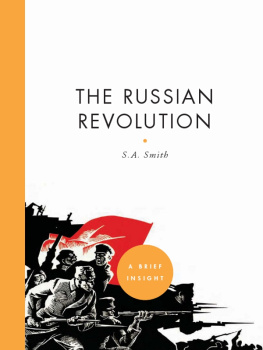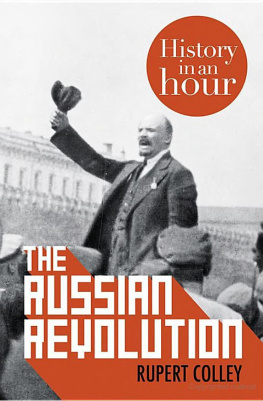
The Russian Revolution
Sheila Fitzpatrick is Bernadotte E. Schmitt Distinguished Service Professor in Modern Russian History at the University of Chicago. Her recent publications include Everyday Stalinism (2000), and Tear off the Masks! Identity and Imposture in Twentieth-Century Russia (2005).
This page intentionally left blank
The Russian
Revolution
THIRD EDITION
Sheila Fitzpatrick





Acknowledgements
The first draft of this book was written in the summer of 1979, when I was a visiting Fellow at the Research School of Social Sciences of the Australian National University. I express my gratitude to my friend Harry (T. H.) Rigby, who arranged my invitation to ANU and subsequently made helpful comments on the manuscript; to R. W. Davies, who made an important correction; and to Jerry Hough, who was a source of intellectual stimulus and encouragement throughout the writing. My students at Columbia University and the University of Texas at Austin were the first audience for much of the book. In the preparation of the second edition in 1993, Jonathan Bone and Joshua Sanborn served as research assistants, and I had helpful discussions with Terry Martin, William Rosenberg, Arch Getty, and Colin Lucas on various questions. Michael Danos, who read the revised manuscript for the second edition, died before the revision of the third; his imprint is lasting. Members of the Russian Studies Workshop at the University of Chicago stimulated my thinking during both revisions. It is a pleasure to note that some who were graduate students at the time of the second edition have since produced important scholarly works that are cited in the third. My thanks are also due to Matthew Cotton, my editor at Oxford University Press, who encouraged me to undertake this revision.
This page intentionally left blank
Contents
v
i
Introduction
THE second edition of The Russian Revolution (1994) appeared in the wake of dramatic events-the fall of the Communist regime and the dissolution of the Soviet Union at the end of 1991. Those events had all sorts of consequences for historians of the Russian Revolution. They opened archives that were previously closed, brought forth memoirs that were hidden in drawers, and released a flood of new material of every kind, especially on the Stalin period and the history of Soviet repression. As a result, the 199os and early 2000s were particularly productive for historians, including postSoviet Russians, newly reconnected to the international scholarly community. In this third edition, readers will find the most important post-1991 works available in English cited in the notes and listed in the bibliography.
For Russians and other former Soviet citizens, the collapse of the Soviet Union meant a fundamental reappraisal of the meaning of the Revolution,' previously hailed as the foundational event of the world's `first socialist state' and now seen by many as a wrong turning that took Russia off course for seventy-four years. While Western historians had less of an adjustment to make, their perspective was subtly changed by the end of the cold war as well as that of the Soviet Union. There are no simple answers in history, but there are interesting questions. The meaning of the great ambiguous turning point of the Russian Revolution is one of them.
Timespan of the revolution
Since revolutions are complex social and political upheavals, historians who write about them are bound to differ on the most basic questions-causes, revolutionary aims, impact on the society, political outcome, and even the timespan of the revolution itself. In the case of the Russian Revolution, the starting point presents no problem: almost everyone takes it to be the `February Revolution'2 of 1917, which led to the abdication of Emperor Nicholas II and the formation of the Provisional Government. But when did the Russian Revolution end? Was it all over by October 1917, when the Bolsheviks took power? Or did the end of the Revolution come with the Bolsheviks' victory in the Civil War in 1920? Was Stalin's `revolution from above' part of the Russian Revolution? Or should we take the view that the Revolution continued throughout the lifetime of the Soviet state?
In his Anatomy of Revolution, Crane Brinton suggested that revolutions have a life cycle passing through phases of increasing fervour and zeal for radical transformation until they reach a climax of intensity, which is followed by the `Thermidorian' phase of disillusionment, declining revolutionary energy, and gradual moves towards the restoration of order and stability.' The Russian Bolsheviks, bearing in mind the same French Revolution model that lies at the basis of Brinton's analysis, feared a Thermidorian degeneration of their own Revolution, and half suspected that one had occurred at the end of the Civil War, when economic collapse forced them into the `strategic retreat' marked by the introduction of the New Economic Policy (NEP) in 1921.
Yet at the end of the 192os, Russia plunged into another upheaval-Stalin's `revolution from above', associated with the industrialization drive of the First Five-Year Plan, the collectivization of agriculture, and a `Cultural Revolution' directed primarily against the old intelligentsia-whose impact on society was greater even than that of the February and October Revolutions of 1917 and the Civil War of 1918-20. It was only after this upheaval ended in the early 1930s that signs of a classic Thermidor can be discerned: the waning of revolutionary fervour and belligerence, new policies aimed at restoring order and stability, revival of traditional values and culture, solidification of a new political and social structure. Yet even this Thermidor was not quite the end of the revolutionary upheaval. In a final internal convulsion, even more devastating than earlier surges of revolutionary terror, the Great Purges of 1937-8 swept away many of the surviving Old Bolshevik revolutionaries, effected a wholesale turnover of personnel within the political, administrative, and military elites, and sent more than a million people to their deaths or imprisonment in Gulag.4
In deciding on a timespan for the Russian Revolution, the first issue is the nature of the `strategic retreat' of NEP in the 1920s. Was it the end of the Revolution, or conceived as such? Although the Bolsheviks' avowed intention in 1921 was to use this interlude to gather strength for a later renewal of the revolutionary assault, there was always the possibility that intentions would change as revolutionary passions subsided. Some scholars think that in the last years of his life, Lenin (who died in 1924) came to believe that for Russia further progress towards socialism could only be achieved gradually, with the raising of the cultural level of the population. Nevertheless, Russian society remained highly volatile and unstable during the NEP period, and the party's mood remained aggressive and revolutionary. The Bolsheviks feared counter-revolution, remained preoccupied with the threat from `class enemies' at home and abroad, and constantly expressed their dissatisfaction with NEP and unwillingness to accept it as the final outcome of the Revolution.
Next page
